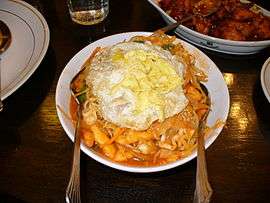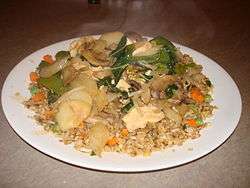Chop suey
| Chop suey | |||||||||||||
 | |||||||||||||
| Traditional Chinese | 雜碎 | ||||||||||||
|---|---|---|---|---|---|---|---|---|---|---|---|---|---|
| Simplified Chinese | 杂碎 | ||||||||||||
| Hanyu Pinyin | zá suì | ||||||||||||
| Cantonese Yale | jaahp seui | ||||||||||||
| Literal meaning |
odds and ends assorted pieces | ||||||||||||
| |||||||||||||
Chop suey (/ˈtʃɒpˈsuːi/) is a dish in American Chinese cuisine and other forms of overseas Chinese cuisine, consisting of meat (often chicken, fish, beef, shrimp, or pork) and eggs, cooked quickly with vegetables such as bean sprouts, cabbage, and celery and bound in a starch-thickened sauce. It is typically served with rice but can become the Chinese-American form of chow mein with the addition of stir-fried noodles.
Chop suey has become a prominent part of American Chinese cuisine, Filipino cuisine, Canadian Chinese cuisine, German Chinese cuisine, Indian Chinese cuisine, and Polynesian cuisine. In Chinese Indonesian cuisine it is known as cap cai (雜菜, "mixed vegetables") and mainly consists of vegetables.
Origins

Chop suey is widely believed to have been invented in America by Chinese Americans, but anthropologist E. N. Anderson, a scholar of Chinese food, traces the dish to tsap seui (杂碎, "miscellaneous leftovers"), common in Taishan (Toisan), a county in Guangdong province, the home of many early Chinese immigrants to the United States.[1][2] Hong Kong doctor Li Shu-fan likewise reported that he knew it in Toisan in the 1890s.[3]
The long list of conflicting stories about the origin of chop suey is, in the words of food historian Alan Davidson, "a prime example of culinary mythology" and typical of popular foods.[4]
One account claims that it was invented by Chinese American cooks working on the transcontinental railroad in the 19th century. Another tale is that it was created during Qing Dynasty premier Li Hongzhang's visit to the United States in 1896 by his chef, who tried to create a meal suitable for both Chinese and American palates. Another story is that Li wandered to a local Chinese restaurant after the hotel kitchen had closed, where the chef, embarrassed that he had nothing ready to offer, came up with the new dish using scraps of leftovers. Yet recent research by the scholar Renqui Yu led him to conclude that "no evidence can be found in available historical records to support the story that Li Hung Chang ate chop suey in the United States." Li brought three Chinese chefs with him, and would not have needed to eat in local restaurants or invent new dishes in any case. Yu speculates that shrewd Chinese American restaurant owners took advantage of the publicity surrounding his visit to promote chop suey as Li's favorite.[5]
Another myth is that, in the 1860s, a Chinese restaurant cook in San Francisco was forced to serve something to drunken miners after hours, when he had no fresh food. To avoid a beating, the cook threw leftovers in a wok and served the miners who loved it and asked what dish is this—he replied "chopped sui".[6] There is no good evidence for any of these stories.[7]
Chop suey appears in an 1884 article in the Brooklyn Eagle, by Wong Chin Foo, "Chinese Cooking", which he says "may justly be so-called the 'national dish of China'."[8] An 1888 description states it was a "staple dish for the Chinese gourmand is chow chop svey [sic], a mixture of chickens' livers and gizzards, fungi, bamboo buds, pigs' tripe, and bean sprouts stewed with spices."[9] In 1898, it is described as "A Hash of Pork, with Celery, Onions, Bean Sprouts, etc."[10]
During his travels in the United States, Liang Qichao, a Guangdong (Canton) native, wrote in 1903 that there existed in the United States a food item called chop suey which was popularly served by Chinese restaurateurs, but which local Chinese people do not eat, because the cooking technique is "really awful".[11]
In earlier periods of Chinese history, "chop suey" or "chap sui" in Cantonese, and "za sui", in Mandarin, has the different meaning of cooked animal offal or entrails. For example, in the classic novel Journey to the West (circa 1590), Sun Wukong tells a lion-monster in chapter 75: "When I passed through Guangzhou, I bought a pot for cooking za sui – so I'll savour your liver, entrails, and lungs." This may be the same as the "Chop Suey Kiang" found in 1898 New York.[10] The term "za sui" (杂碎) is found in newer Chinese-English dictionaries with both meanings listed: cooked entrails, and chop suey in the Western sense.
In popular culture
The jazz musician Louis Armstrong recorded "Cornet Chop Suey" in 1925 or 1926. [12]
The idea of chop suey was featured as a theme in the 1958 musical Flower Drum Song.
In the comic strip Pogo, Albert the alligator has a recurring song that begins with "I was eatin' some chop suey / With a lady in St. Louie."
In 2001, Armenian-American alternative metal group System Of A Down made the song, "Chop Suey!"
Chop suey also features prominently in the prescribed story on the Irish Leaving Cert, "An Gnáthrud".
Ramones has a song called Chop Suey made for the soundtrack of the film Get Crazy
See also
References
- ↑ E. N. Anderson, The Food of China, Yale University Press, 1990, ISBN 0300047398, p. 216
- ↑ E. N. Anderson, "Guangzhou (Canton) Cuisine", in Solomon H. Katz. Encyclopedia of Food and Culture. (New York: Scribner's, 2003; Vol I ISBN 0684805685), p. 392.
- ↑ E. N. Anderson Jr. and Marja L. Anderson, "Modern China: South" in K. C. Chang, Food in Chinese Culture: Anthropological and Historical Perspectives, Yale, 1977. p. 355.
- ↑ Alan Davidson. The Oxford Companion to Food. (Oxford: Oxford University Press, 1999; ISBN 0192115790), p. 182.
- ↑ "Chop Suey: From Chinese Food to Chinese American Food", Chinese America: History and Perspectives 87 (1987): 91–93
- ↑ Joseph R. Conlin, Bacon, Beans and Galantines: Food and Foodways on the Western Mining Frontier, University of Nevada Press: Reno 1986, pp. 192–3
- ↑ Madeline Y. Hsu, "From Chop Suey to Mandarin Cuisine: Fine Dining and the Refashioning of Chinese Ethnicity During the Cold War Era," in Sucheng Chan, Madeline Yuan-yin Hsu, eds., Chinese Americans and the Politics of Race and Culture (Philadelphia: Temple University Press, 2008): 173–193. full text in PDF
- ↑ Andrew Coe, Chop Suey: A Cultural History of Chinese Food in the United States (New York: Oxford University Press, 2009), p. 155.
- ↑ Current Literature, October 1888, p. 318, as quoted in the Oxford English Dictionary, Second Edition, 1989.
- 1 2 Louis Joseph Beck, New York's Chinatown: An Historical Presentation of Its People and Places, p. 50 full text at Google Books
- ↑ Liang, Q. (1903) 新大陆游记 (Travels in the New Continent). Beijing: Social Sciences Documentary Press (reprint 2007). ISBN 7-80230-471-7. “然其所谓杂碎者,烹饪殊劣,中国人从无就食者。”
- ↑ Cornet Chop Suey YouTube
Further reading
- E. N. Anderson, The Food of China, Yale University Press, 1988.
- Chen, Yong (2014). Chop Suey, USA: The Story of Chinese Food in America. New York: Columbia University Press. ISBN 9780231168922.
- Andrew Coe, Chop Suey: A Cultural History of Chinese Food in the United States, 2009. ISBN 0-19-533107-9.
- Alan Davidson, The Oxford Companion to Food, 1999.
- Monica Eng, "Chop Suey or Hooey?", orig. Chicago Tribune, January 4, 2006, online rpr. Honolulu Advertiser,
- Charles Hayford, "Who's Afraid of Chop Suey?", Education About Asia 16.3 Winter 20110
- Liu, Haiming (2009-02-16). "Chop Suey as Imagined Authentic Chinese Food: The Culinary Identity of Chinese Restaurants in the United States" (PDF). Journal of Transnational American Studies. 1 (1). ISSN 1940-0764.
- Crow, Carl (September 1937). "Sharks' fins and ancient eggs". Harper's. Retrieved 23 March 2018. (subscription required)
- Cookbooks with recipes for chop suey and accounts of Chinese American cuisine
- Hom, Ken. Easy Family Recipes from a Chinese American Childhood. New York: Alfred A. Knopf, 1997.
- Yin-Fei Lo, Eileen. The Chinese Kitchen: Recipes, Techniques and Ingredients, History, and Memories from America’s Leading Authority on Chinese Cooking. New York: William Morrow, 1999.
A recipe of a variant using Mexican-style beans and rice was published in an NPR article: Chatterjee, Rhitu (2017-08-03). "A Classic Chinese-American Dish Takes On A Mexican Flair". NPR.
.jpg)
